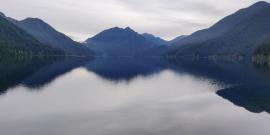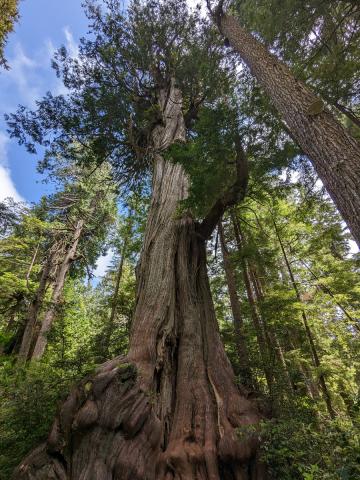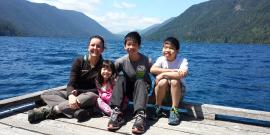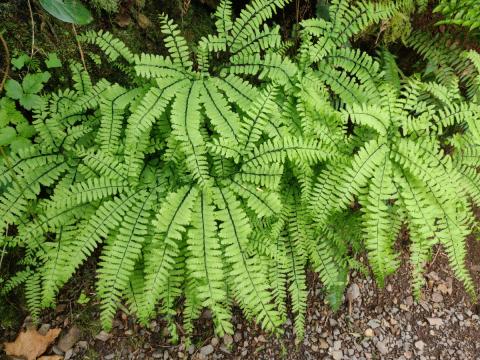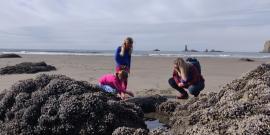
Who better to guide you on Lake Crescent than a guide who lived there
Lake Crescent is great for hiking and birding year-round, especially when looking for resident species like American Dipper and Pacific Wren.
Barnes Point is packed with trails and we can help you find some peace and quiet, even on a busy summer day so sign up today for private guided nature day tour that includes Lake Crescent.
Carolyn know the entirety of Barnes Point well because she worked at Olympic Park Institute (now NatureBridge Olympic). She can guide you to an otter latrine site, an American Dipper nest, a Red-breasted Sapsucker cavity site, and more.
Lake Crescent is an Olympic National Park gem
Lake Crescent was formed by glaciers and is an extremely large, deep, and clear lake. One of the best scenic drives in Olympic National Park is the 12 mile drive around Lake Crescent. The area surrounding the lake is a place of great cultural and historical significance.
Barnes Point is the largest area of flat land on Lake Crescent and includes Marymere Falls, the Lake Crescent Lodge, the historic Rosemary Inn, Bovee's Meadow, old-growth Western Red Cedar groves, the short Moments in Time trail, and Storm King Ranger Station.
Lake Crescent Past and Present
Lake Crescent was originally a part of the Elwha River watershed but Klallam oral history and geologic history tell the story of a giant landslide that separated Lake Crescent and Lake Sutherland. This giant landslide cut off Lake Crescent from its former Indian Creek outflow to the Elwha River.
The outflow of Lake Crescent presently is the Lyre River and Lyre River falls does not allow fish passage. Two fish species are endemic to Lake Crescent as a result of this isolation: Beardslee and Crescenti Trout.
Barnes Creek Western Red Cedar Groves
Thanks to the Quileute and Klallam people as well as early settlers of Barnes Point like Rose (Saylor) Littleton and Mary Daum, who operated the Rosemary Inn (now the dining hall of NatureBridge), there are readily accessible groves of ancient Western Red Cedar, Grand Fir, and Douglas Fir on Barnes Point in Olympic National Park for future generations to enjoy.
Old-Growth Western Red Cedar is especially difficult to find in the front country (near roads) anywhere on the Olympic Peninsula because of its importance as a wood product. Douglas Fir Plantations have replaced ancient Western Red Cedar forests (that were mostly felled using saws and horses as well as leaving behind dead wood for forest regeneration).
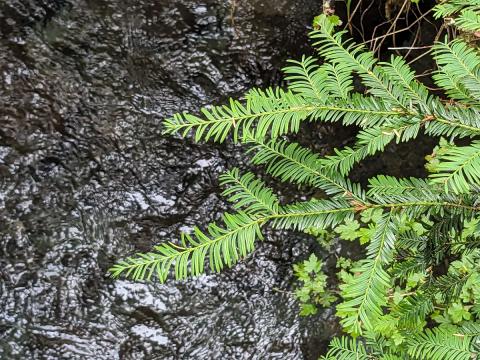
A Tree you might Walk Right By Without a Nature Guide
Western or Pacific Yew (Taxus brevifolia) is a small understory coniferous tree that might be confused with a young Western Hemlock tree due to similar short needles.
It is slow growing and found in dense forests, often along stream banks. On Barnes Point, it is growing along Barnes Creek and on the Marymere Falls trail.
Like other yews, it is a source of Taxol (a chemotherapy drug) and was used medicinally by indigenous people across its range.
Mascot of Healthy Forests
The Banana Slug is an iconic forest denizen that processes scat, fungi, and vegetation. It is also a common trail-side invertebrates along with millipedes and ground beetles.
Banana Slugs are well suited to their environment and can produce a slime capsule around them in order to avoid desiccation. During the summer, you often only find them near water bodies or associated with nurse logs. They disappear in winter and reappear once temperatures warm, being most active in spring and fall.
